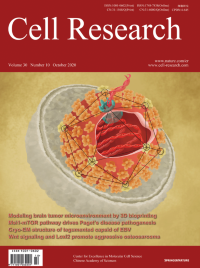
Advanced Search
Submit Manuscript
Advanced Search
Submit Manuscript
Volume 30, No 10, Oct 2020
ISSN: 1001-0602
EISSN: 1748-7838 2018
impact factor 17.848*
(Clarivate Analytics, 2019)
Volume 30 Issue 10, October 2020: 833-853
Three-dimensional bioprinted glioblastoma microenvironments model cellular dependencies and immune interactions
Min Tang1 , Qi Xie2,3,4,5,6,* , Ryan C. Gimple2,3,7 , Zheng Zhong1 , Trevor Tam1 , Jing Tian1 , Reilly L. Kidwell2,3 , Qiulian Wu2,3 , Briana C. Prager2,3,7,8 , Zhixin Qiu2,3 , Aaron Yu2,3 , Zhe Zhu2,3 , Pinar Mesci3,9,10 , Hui Jing11 , Jacob Schimelman1 , Pengrui Wang12 , Derrick Lee2,3 , Michael H. Lorenzini2,3 , Deobrat Dixit2,3 , Linjie Zhao2,3 , Shruti Bhargava2,3 , Tyler E. Miller13 , Xueyi Wan14 , Jing Tang4,5,6 , Bingjie Sun1 , Benjamin F. Cravatt11 , Alysson R. Muotri3,9,10,15,16 , Shaochen Chen1,12,17,* , Jeremy N. Rich2,3,18,*
1Department of NanoEngineering, University of California San Diego, 9500 Gilman Drive, La Jolla, CA 92093, USABrain tumors are dynamic complex ecosystems with multiple cell types. To model the brain tumor microenvironment in a reproducible and scalable system, we developed a rapid three-dimensional (3D) bioprinting method to construct clinically relevant biomimetic tissue models. In recurrent glioblastoma, macrophages/microglia prominently contribute to the tumor mass. To parse the function of macrophages in 3D, we compared the growth of glioblastoma stem cells (GSCs) alone or with astrocytes and neural precursor cells in a hyaluronic acid-rich hydrogel, with or without macrophage. Bioprinted constructs integrating macrophage recapitulate patient-derived transcriptional profiles predictive of patient survival, maintenance of stemness, invasion, and drug resistance. Whole-genome CRISPR screening with bioprinted complex systems identified unique molecular dependencies in GSCs, relative to sphere culture. Multicellular bioprinted models serve as a scalable and physiologic platform to interrogate drug sensitivity, cellular crosstalk, invasion, context-specific functional dependencies, as well as immunologic interactions in a species-matched neural environment.
https://doi.org/10.1038/s41422-020-0338-1